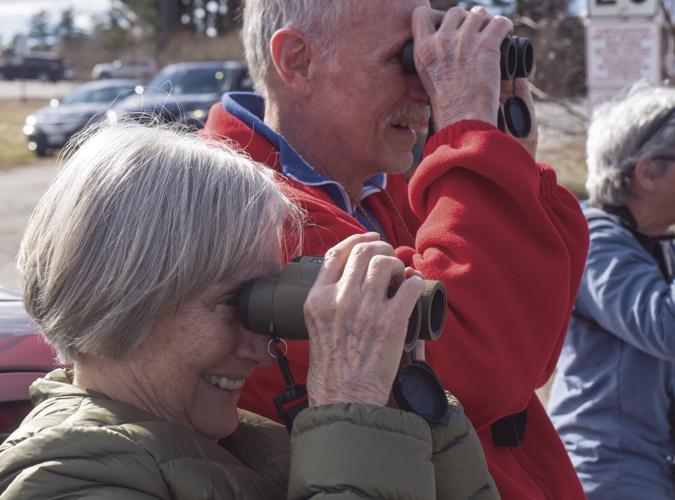LACONIA — Birders flocked to Ahern State Park to see a rare sighting of the loggerhead shrike, spotted first on Monday. This songbird is seen commonly in the South and throughout the rest of the United States except in the Northeast.
To see a loggerhead shrike in New Hampshire is rare. The bird used to be common in New Hampshire in the early 1900s when there were more animal pastures, but as their preferred habitat began to disappear in the state, so did the loggerhead shrike, according to Iain MacLeod, executive director of the Squam Lakes Natural Science Center. MacLeod was the first to identify the loggerhead shrike at Ahern State Park on Monday.
“I just happened to glance over and saw the bird on a shrub, and I realized it was a shrike,” MacLeod said.
The last time the bird was seen in New Hampshire, according to a sightings map on the eBird website, was in May 24, 2020, documented and photographed by Robin Feustel. It was seen previously on July 18, 1997 in Newington by Stephen Mirick. This year’s sighting is unique due to how many people identified it, and how many photos were taken.
The bird boasts a blue-gray head and back, with a combination of black and white coloration on its body and wings, with a black mask over its eyes and beak. The moniker “loggerhead” refers to the relatively large size of its head compared to the rest of its body. It averages about 8 to 10 inches in length with a wingspan of about 13 inches, according to the Smithsonian National Zoo and Conservation Biology Institute.
Wildlife biologist Brett Hillman, 36, with the White Mountain National Forest Service in Campton, was out looking for the bird on Tuesday with a camera and a telephoto lens. He said he heard about the sighting through a rare bird alert from the eBird website.
“I've seen these birds in Florida, pretty common down south, but I've never seen one in New Hampshire,” Hillman said. “It's kind of a big deal to see one so close to home.”
Hillman mentioned there are many reasons for a bird to end up outside of its usual geographic home.
“Sometimes birds just get lost. This is migration season, so they're moving around,” Hillman said. “Something goes on with its internal compass and it’ll just end up somewhere it's not supposed to. It happens every year.”
Married couple Linda Hunter, 71, and Richard Dawson, 75, from Durham, are hobbyist birdwatchers that have been birding for over 40 years. In their retirement, they have been able to dedicate more time to their hobby. On Tuesday, they spent an hour and a half searching before they noticed the bird in the shrubs near a small shed.
“We drove up from Durham so it would have been a disappointing ride home if we didn't see it,” Hunter said.
Hunter said they were often fooled by mockingbirds when looking for the loggerhead shrike due to its similarities in physical characteristics and habitat.
“They have a long tail like the shrike. They have similar coloration except that the shrike has a lot bolder patterns than the mockingbird, but they share the same habitat,” she said.
Patience is required for birdwatching, Dawson said, adding that it takes a little while before being able to accurately identify a bird.
“Sometimes if it's in shrubbery like that, you can see there's a bird in there but until he actually moves and you can get a bead on his coloration, sometimes you're not sure until you really get them up close,” Dawson said.
For those who may want to see it, it may be too late.
“It could hang around here and eat bugs and flies for weeks, or it could get eaten by a hawk since it's not used to this area, he doesn't know where to hide or anything like that,” Hillman said. “It could just realize, ‘I'm in the wrong place’ and then turn around in a few days.”
Being the first to identify a rare bird sighting is not an easy feat. Hillman hopes through his continued observations, to be the first to identify a bird.
“For the person who actually found it, that person must be really excited to be the first one to find it,” he said. “I'm hoping that someday I'll find a bird like this on my own.”




















(0) comments
Welcome to the discussion.
Log In
Keep it Clean. Please avoid obscene, vulgar, lewd, racist or sexually-oriented language.
PLEASE TURN OFF YOUR CAPS LOCK.
Don't Threaten. Threats of harming another person will not be tolerated.
Be Truthful. Don't knowingly lie about anyone or anything.
Be Nice. No racism, sexism or any sort of -ism that is degrading to another person.
Be Proactive. Use the 'Report' link on each comment to let us know of abusive posts.
Share with Us. We'd love to hear eyewitness accounts, the history behind an article.